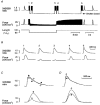Changes in force and cytosolic Ca2+ concentration after length changes in isolated rat ventricular trabeculae
- PMID: 9490870
- PMCID: PMC2230716
- DOI: 10.1111/j.1469-7793.1998.431bw.x
Changes in force and cytosolic Ca2+ concentration after length changes in isolated rat ventricular trabeculae
Abstract
1. Changes in cytosolic [Ca2+] ([Ca2+]i) were measured in isolated rat trabeculae that had been micro-injected with fura-2 salt, in order to investigate the mechanism by which twitch force changes following an alteration of muscle length. 2. A step increase in length of the muscle produced a rapid potentiation of twitch force but not of the Ca2+ transient. The rapid rise of force was unaffected by inhibiting the sarcoplasmic reticulum (SR) with ryanodine and cyclopiazonic acid. 3. The force-[Ca2+]i relationship of the myofibrils in situ, determined from twitches and tetanic contractions in SR-inhibited muscles, showed that the rapid rise of force was due primarily to an increase in myofibrillar Ca2+ sensitivity, with a contribution from an increase in the maximum force production of the myofibrils. 4. After stretch of the muscle there was a further, slow increase of twitch force which was due entirely to a slow increase of the Ca2+ transient, since there was no change in the myofibrillar force-[Ca2+]i relationship. SR inhibition slowed down, but did not alter the magnitude of, the slow force response. 5. During the slow rise of force there was no slow increase of diastolic [Ca2+]i, whether or not the SR was inhibited. The same was true in unstimulated muscles. 6. We conclude that the rapid increase in twitch force after muscle stretch is due to the length-dependent properties of the myofibrils. The slow force increase is not explained by length dependence of the myofibrils or the SR, or by a rise in diastolic [Ca2+]i. Evidence from tetani suggests the slow force responses result from increased Ca2+ loading of the cell during the action potential.
Figures










Similar articles
-
Myocardial stretch alters twitch characteristics and Ca2+ loading of sarcoplasmic reticulum in rat ventricular muscle.Cardiovasc Res. 1992 Sep;26(9):865-70. doi: 10.1093/cvr/26.9.865. Cardiovasc Res. 1992. PMID: 1451163
-
The relationship between contractile force and intracellular [Ca2+] in intact rat cardiac trabeculae.J Gen Physiol. 1995 Jan;105(1):1-19. doi: 10.1085/jgp.105.1.1. J Gen Physiol. 1995. PMID: 7730787 Free PMC article.
-
Contribution of impaired myofibril and ryanodine receptor function to prolonged low-frequency force depression after in situ stimulation in rat skeletal muscle.J Muscle Res Cell Motil. 2015 Jun;36(3):275-86. doi: 10.1007/s10974-015-9409-1. Epub 2015 Feb 20. J Muscle Res Cell Motil. 2015. PMID: 25697123
-
Sarcomere mechanics in uniform and non-uniform cardiac muscle: a link between pump function and arrhythmias.Prog Biophys Mol Biol. 2008 Jun-Jul;97(2-3):312-31. doi: 10.1016/j.pbiomolbio.2008.02.013. Epub 2008 Feb 15. Prog Biophys Mol Biol. 2008. PMID: 18394686 Review.
-
Intracellular calcium movements during excitation-contraction coupling in mammalian slow-twitch and fast-twitch muscle fibers.J Gen Physiol. 2012 Apr;139(4):261-72. doi: 10.1085/jgp.201210773. J Gen Physiol. 2012. PMID: 22450485 Free PMC article. Review.
Cited by
-
Rate-dependent changes of twitch force duration in rat cardiac trabeculae: a property of the contractile system.J Physiol. 2000 Apr 1;524 Pt 1(Pt 1):221-31. doi: 10.1111/j.1469-7793.2000.t01-3-00221.x. J Physiol. 2000. PMID: 10747194 Free PMC article.
-
Cellular interplay via cytokine hierarchy causes pathological cardiac hypertrophy in RAF1-mutant Noonan syndrome.Nat Commun. 2017 May 26;8:15518. doi: 10.1038/ncomms15518. Nat Commun. 2017. PMID: 28548091 Free PMC article.
-
A mathematical model of the slow force response to stretch in rat ventricular myocytes.Biophys J. 2007 Jun 1;92(11):4030-44. doi: 10.1529/biophysj.106.095463. Epub 2007 Mar 16. Biophys J. 2007. PMID: 17369410 Free PMC article.
-
Inhibition of hypertrophy is a good therapeutic strategy in ventricular pressure overload.Circulation. 2015 Apr 21;131(16):1435-47. doi: 10.1161/CIRCULATIONAHA.115.013894. Circulation. 2015. PMID: 25901069 Free PMC article. Review. No abstract available.
-
The cardiac muscle duplex as a method to study myocardial heterogeneity.Prog Biophys Mol Biol. 2014 Aug;115(2-3):115-28. doi: 10.1016/j.pbiomolbio.2014.07.010. Epub 2014 Aug 5. Prog Biophys Mol Biol. 2014. PMID: 25106702 Free PMC article. Review.
References
-
- Allen DG. On the relationship between action potential duration and tension in cat papillary muscle. Cardiovascular Research. 1977;11:210–218. - PubMed
-
- Allen DG, Kentish JC. The cellular basis of the length-tension relationship in cardiac muscle. Journal of Molecular and Cellular Cardiology. 1985;17:821–840. - PubMed
Publication types
MeSH terms
Substances
Grants and funding
LinkOut - more resources
Full Text Sources
Research Materials
Miscellaneous

